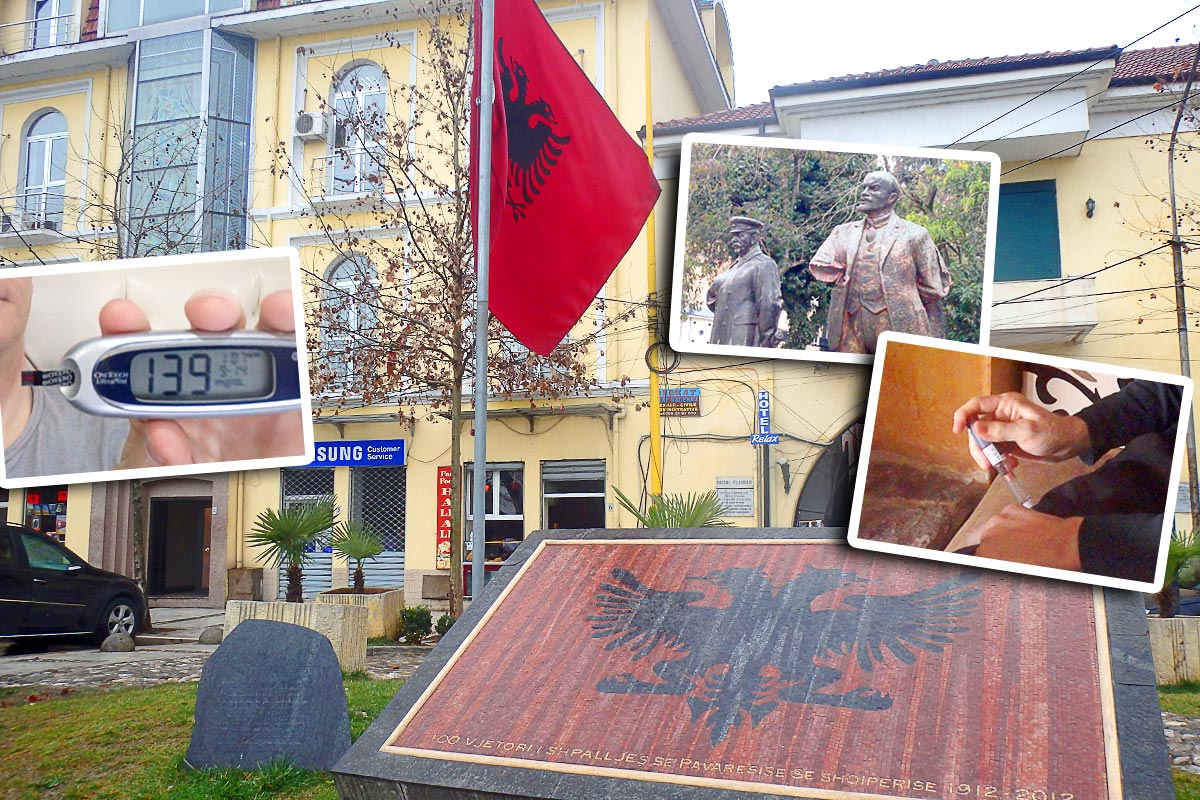
Visiting the small country of Albania with diabetes can be smooth and problem free. Albania is an opening and emerging country, and infrastructure in transportation and medicine are progressing rapidly.
For the traveling diabetic, Albania should present no problem at all, especially if you do a little preparation and gain a little understanding about the country.
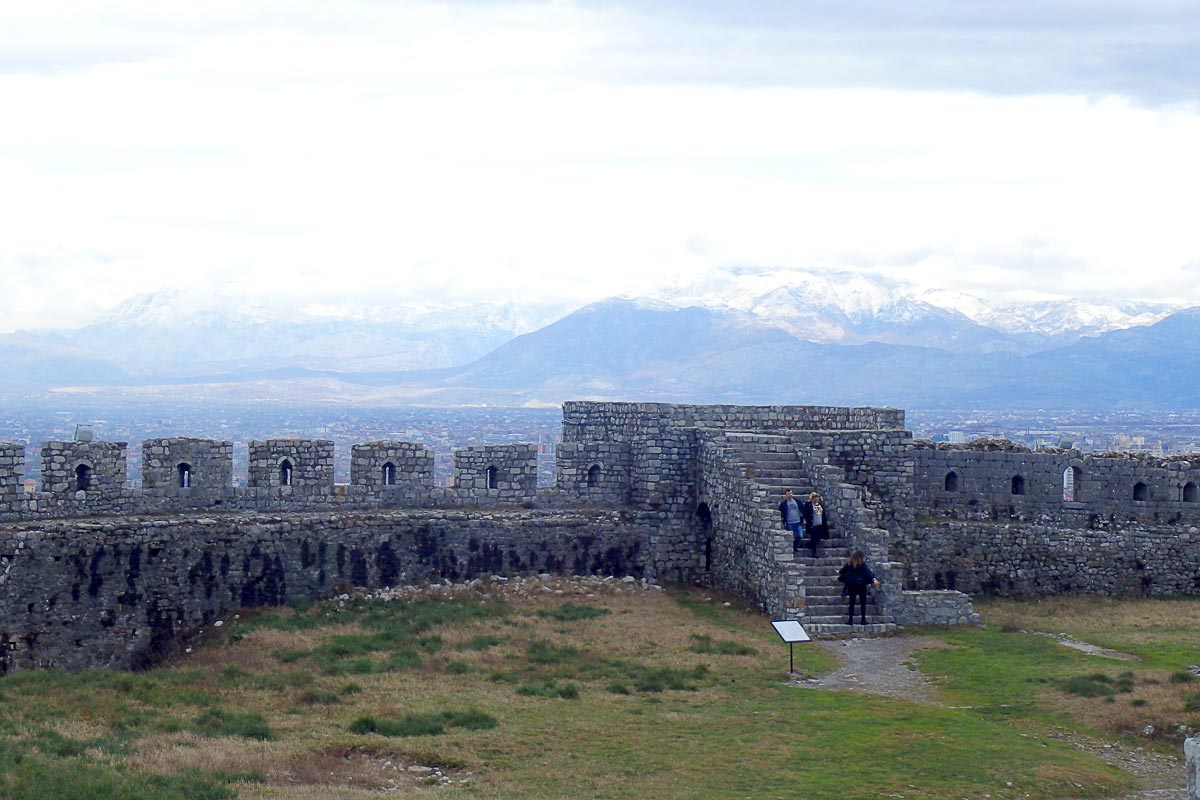
This is your guide to getting the most out of Albania with diabetes and avoiding complications or problems there. In this guide you’ll find:
- Information about food you’ll find in Albania
- Tips on controlling blood sugar while taking transportation around Albania
- General info about facilities in Albania
- Details about my own experiences in Albania as a Type 1 diabetic
- How to communicate with Albanians about diabetes
- Basic travel inspiration – in case you’re not convinced to go yet!
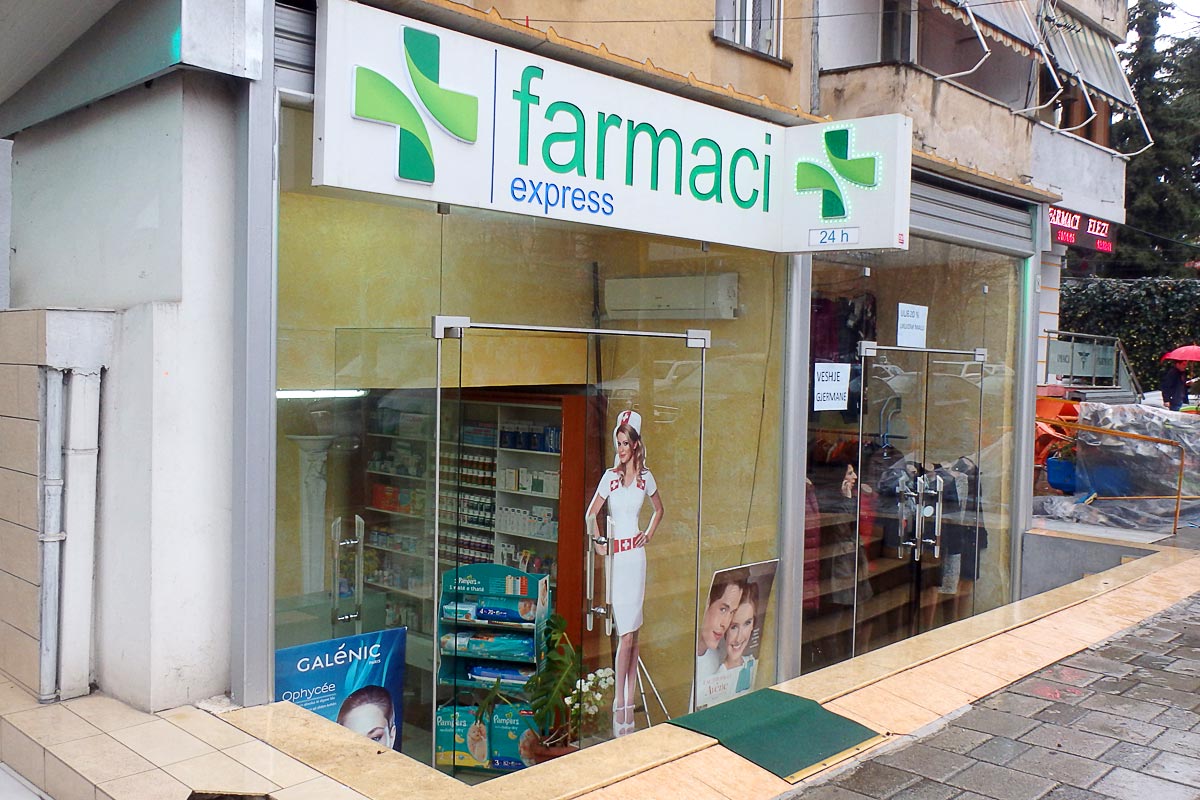
Albania with diabetes overview
Albania is a small country on the Adriatic Sea between Greece, Macedonia, Kosovo, and Montenegro. It has some historical and cultural ties to nearby Italy as well. The country was closed to most outsiders for many years – you could call it the North Korea of the 20th century – and is just now in the process of opening up.
This means that shops, restaurants, pharmacies, clinics, and hospitals are increasingly easy to find. It also means transportation within the country and to its neighbors is improving.
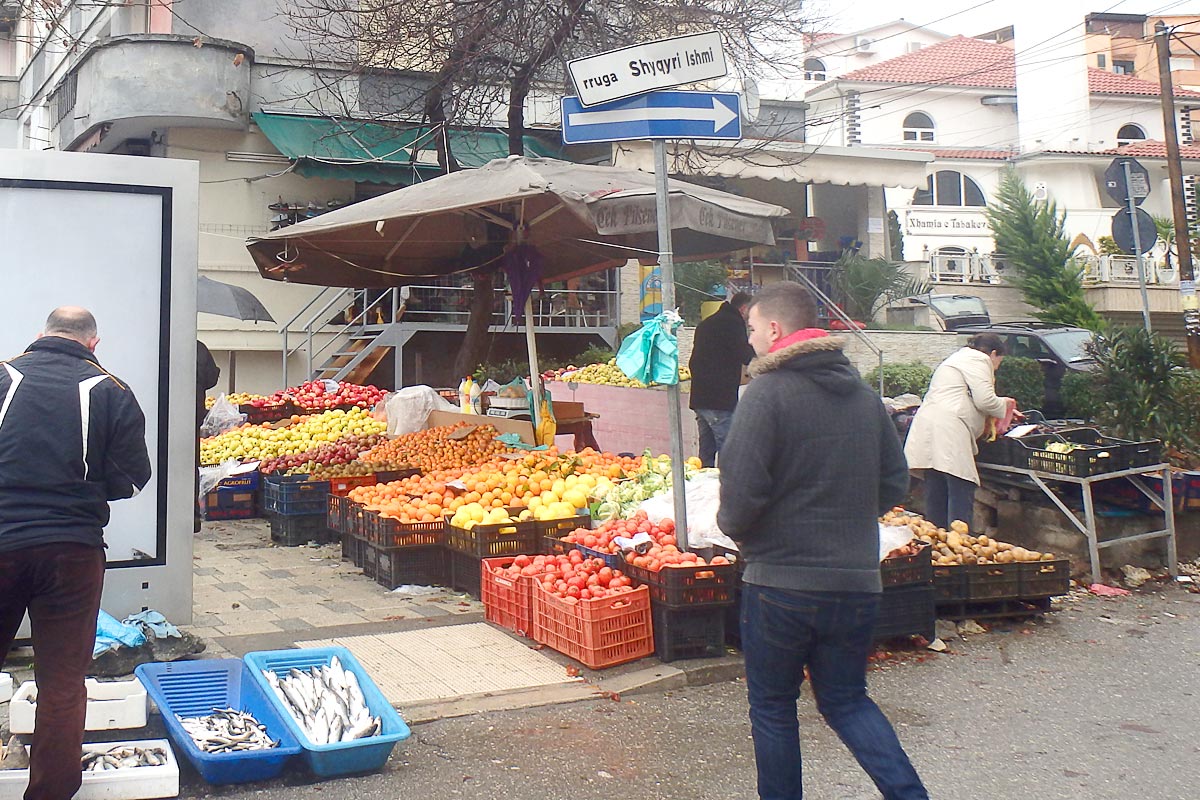
Of course, while reforms can be swift they don’t happen overnight, and facilities and infrastructure on the ground are occasionally sparse for anyone visiting Albania with diabetes.
But everything you need is indeed available – it just may take a little more preparation than usual. Don’t let that dissuade you, however; Albania is a modern country that will accommodate you. Don’t let a little thing like diabetes scare you!
How to speak Albanian – for T1Ds
Communicating about having diabetes is particularly easy in Albanian – the most common way to say it is the English phrase diabetes mellitus, which will be understood by anyone important enough to matter (pharmacists, doctors, et cetera). “Insulin” is insulinë – obviously, medical professionals will be fine with the English versions.
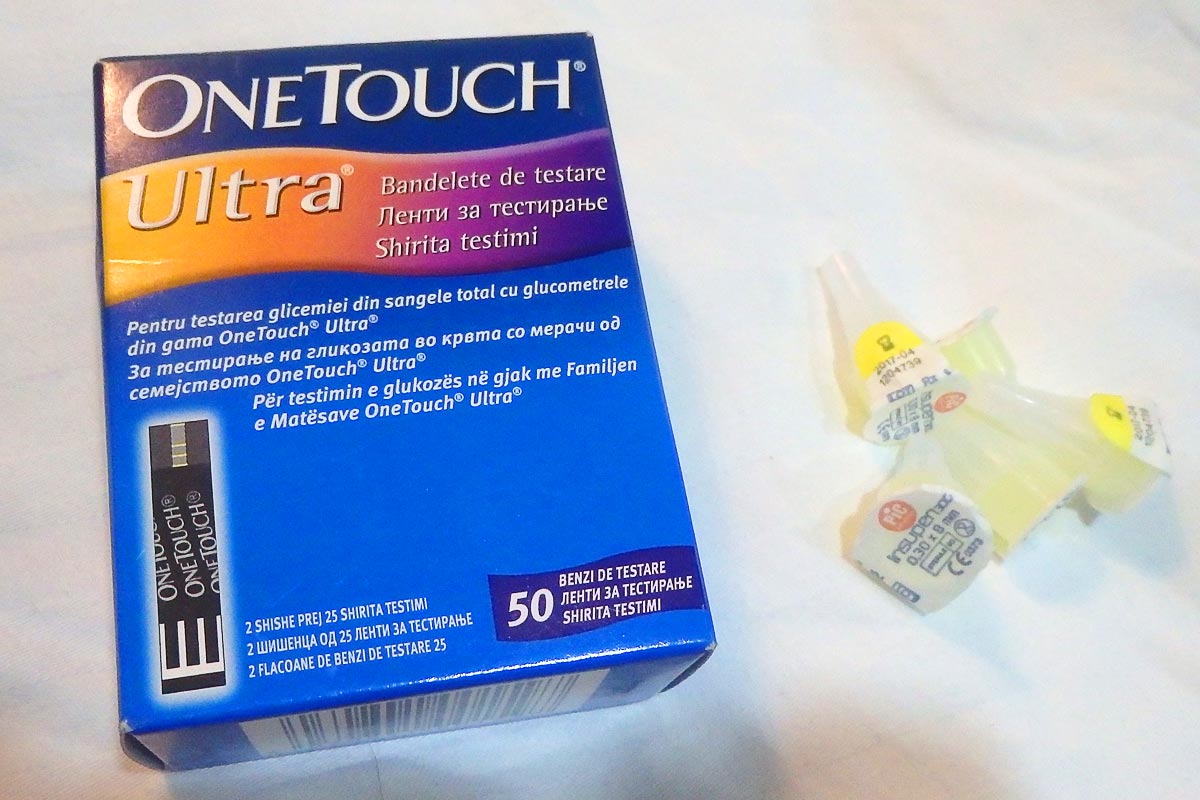
As an example, OneTouch sells test strips with specifically Albanian packaging.
If you want to get really fancy you can call diabetes sëmundja e sheqerit, which roughly means “sugar disease”. But it won’t be necessary per se. Just say “diabetes” in English, or try the more local pronunciation “dee a beh tee”, and even non-English speakers will understand. (Again, any medical personnel you speak with will probably understand English pretty well.)
Despite the ease of communication, and the fact that insulin and blood sugar supplies are available in many forms in Albania, it is a good idea to wear something that identifies you as a “DIABETIC” or “DM” or “T1D”. If you don’t want to or can’t wear a medical-alert necklace, bracelet, or anklet, you can carry a card in your pocket.
There is very little likelihood it will be useful, but it’s good for peace of mind if nothing else.
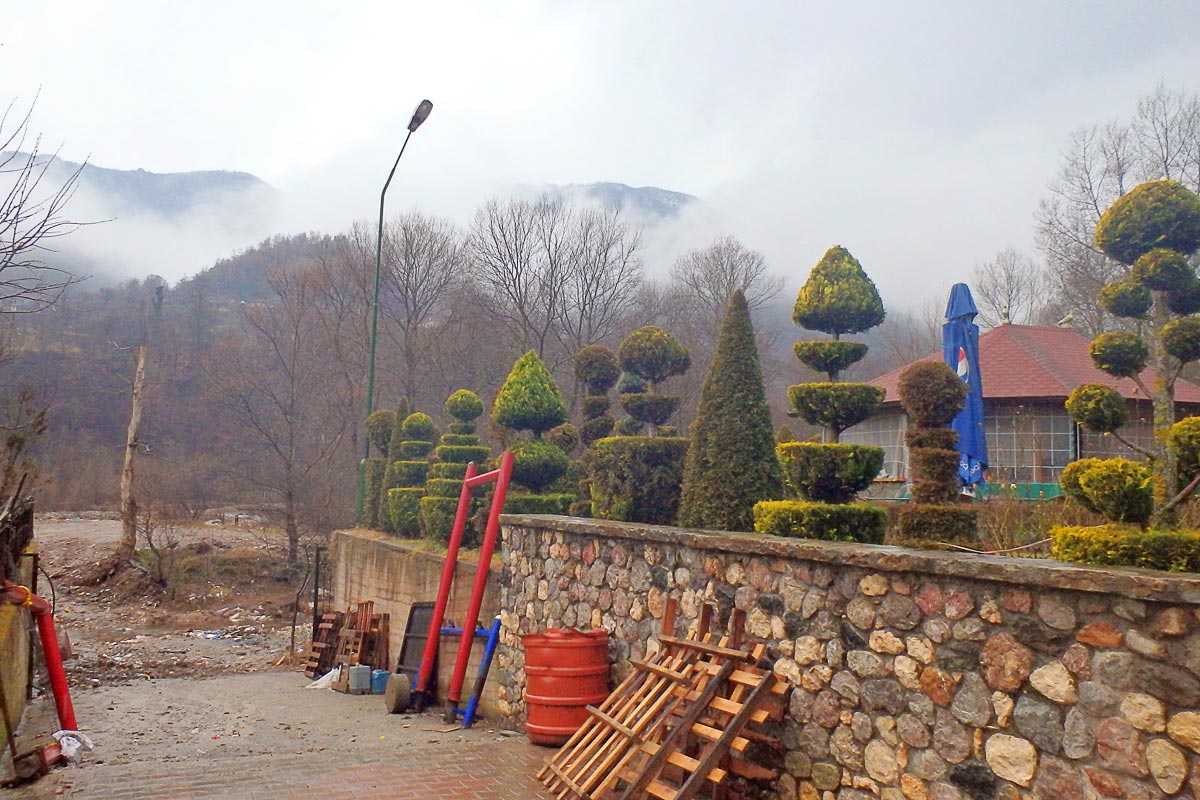
The two rules to traveling in Albania with diabetes
If you take care of two fairly simple things your trip to Albania will be much more successful. Diabetes isn’t too difficult to travel with, but it is a factor to consider.
These two things will help your trip immeasurably:
- Preparation.
It doesn’t take much to prepare for diabetes travel – just take your supplies and pack them well. That means calculating the insulin, testing supplies, needles, and whatever other medications and/or supplies you’ll need to get you through your scheduled time in Albania, and doubling it. Split everything into two halves and put them in separate pieces of luggage. (A big bag, generally left back in the hotel, and a day pack you always carry would be ideal.) Hotels and guesthouses will often have refrigerators in your room or in the lobby to keep your insulin cool if you need it. Preparation also includes making sure you always have low blood sugar snacks on you at all times (see below). - Attitude.
This is by far the most important aspect to traveling to Albania with diabetes, and is probably the number one thing that keeps some ‘betics from traveling at all. The accurate and helpful attitude to have when traveling is this: Nothing bad will happen to you in Albania. Memorize it and internalize it. Emergencies are obviously possible, but don’t inflate their likelihood. Watch your blood sugar, do and eat what you want, and you’ll be fine even if your BG isn’t perfect all the time. Nothing bad will happen to you and your diabetes in Albania!
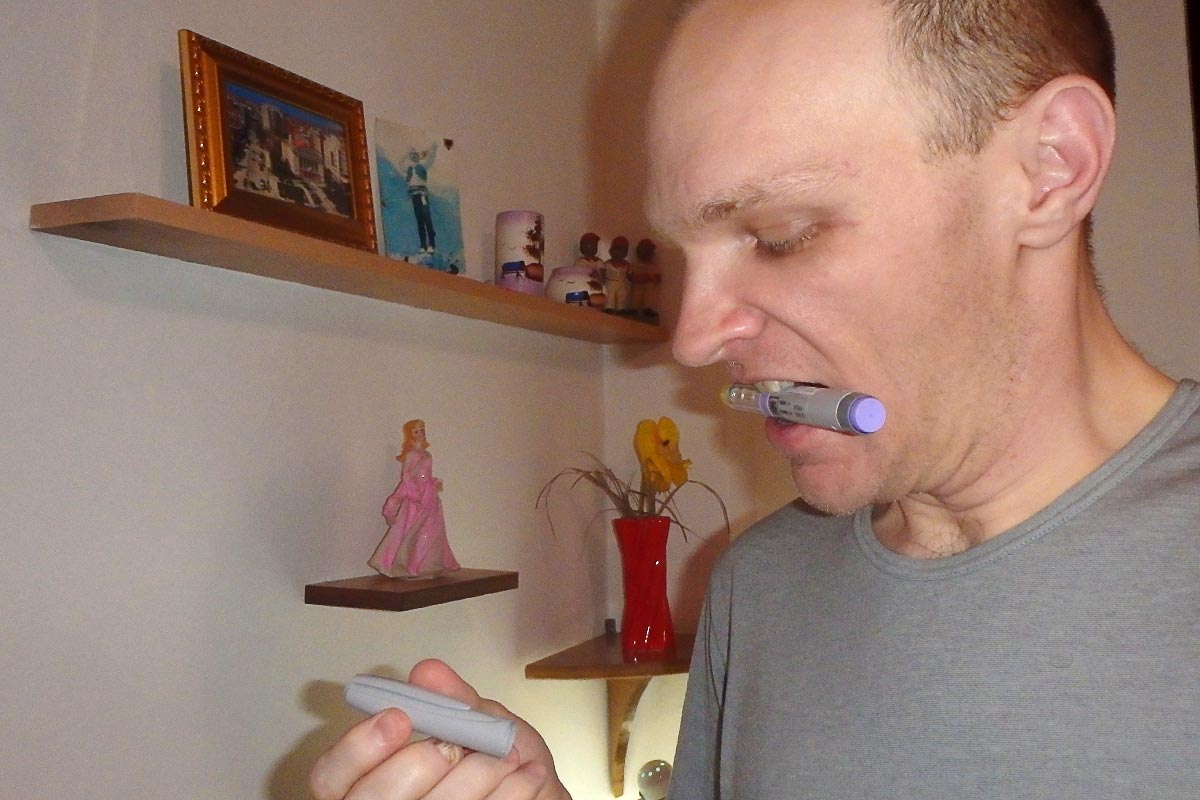
Food and insulin in Albania
Albanian food has influences from Greece and Italy as well as the other areas of the Balkan Peninsula. This means that seafood and bread and meat and potatoes are common. The realities of travel also mean that you’ll sometimes have to eat whatever you can find – especially if you’re on a budget and/or in a smaller town.
Some of the foods you’ll come across in Albania can include:
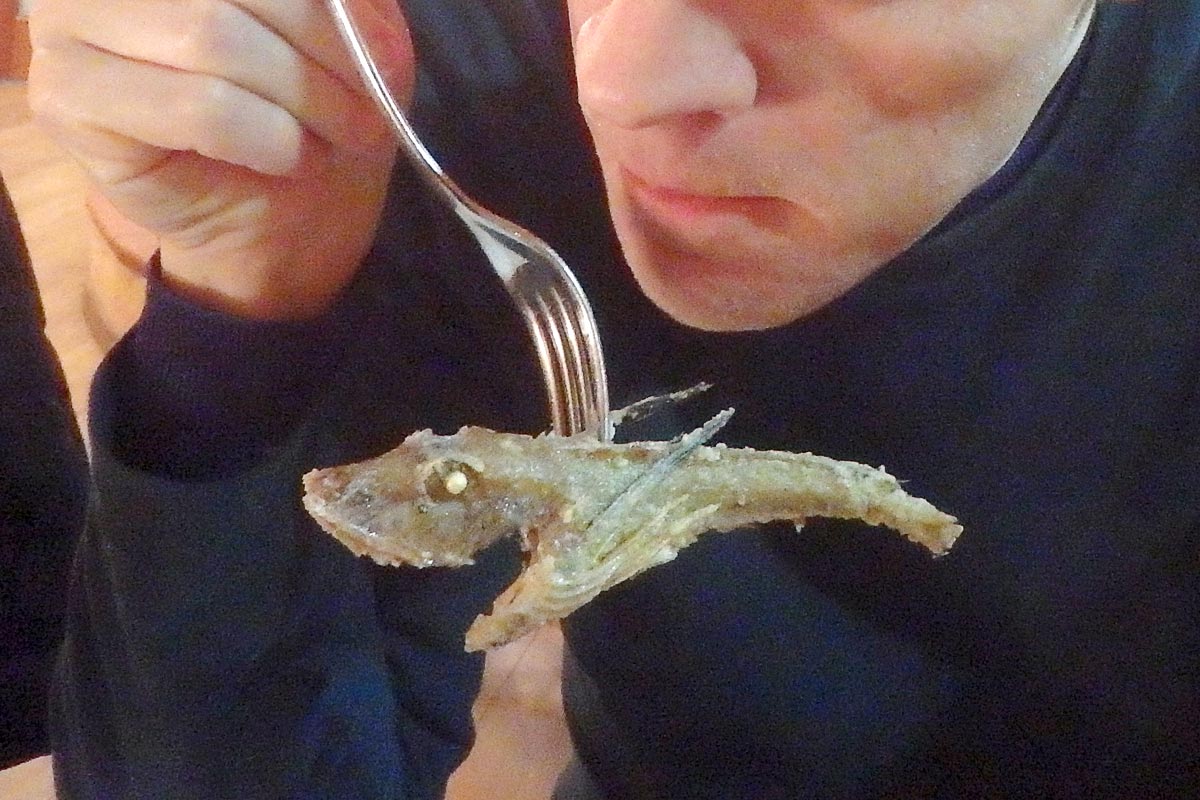
- Restaurant dinners – Potatoes in sauce, fried seafood, and French fries are some of the things that are easy to find and, diabetically, somewhat predictable in Albania. Of course things like batter and especially potatoes can be tough for blood sugar. But if you calculate your dose carefully you should be ok – the main thing to remember is to check soon afterwards and learn from your the reading. (If it’s no good, don’t get discouraged! Just note what happened and try to do better next time.)
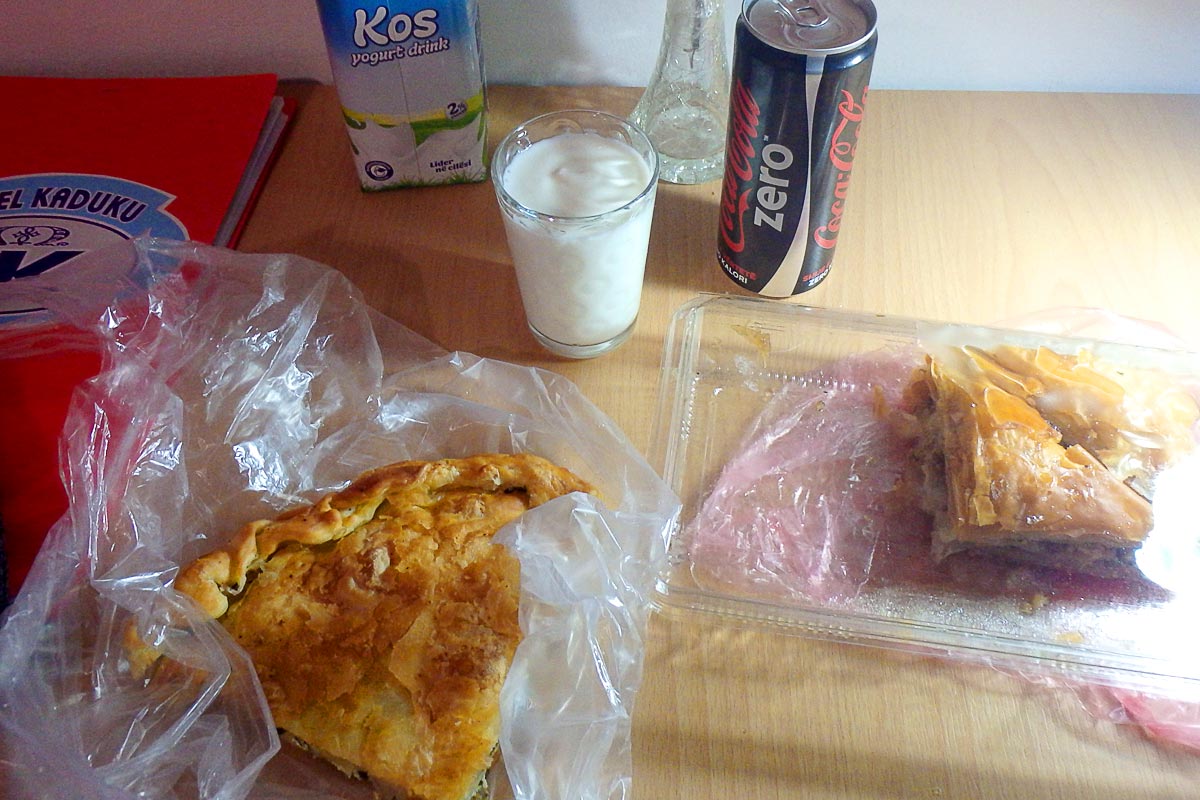
Burek, yogurt, baklava, and soda. A real international meal.
- Burek and baklava – Common southern Europe foods like these are great for snacks or entire meals. Burek is a kind of fried bread with meat, cheese, or vegetables inside, while baklava is a sweet fried dessert. These types of food are pretty easy to find even in small towns, and while probably not suitable for every meal can be fine for the occasional casual feast. Burek is usually not too high in carbs, even when dripped with yogurt, but baklava can be. Choose a robust insulin dose. Check afterwards!
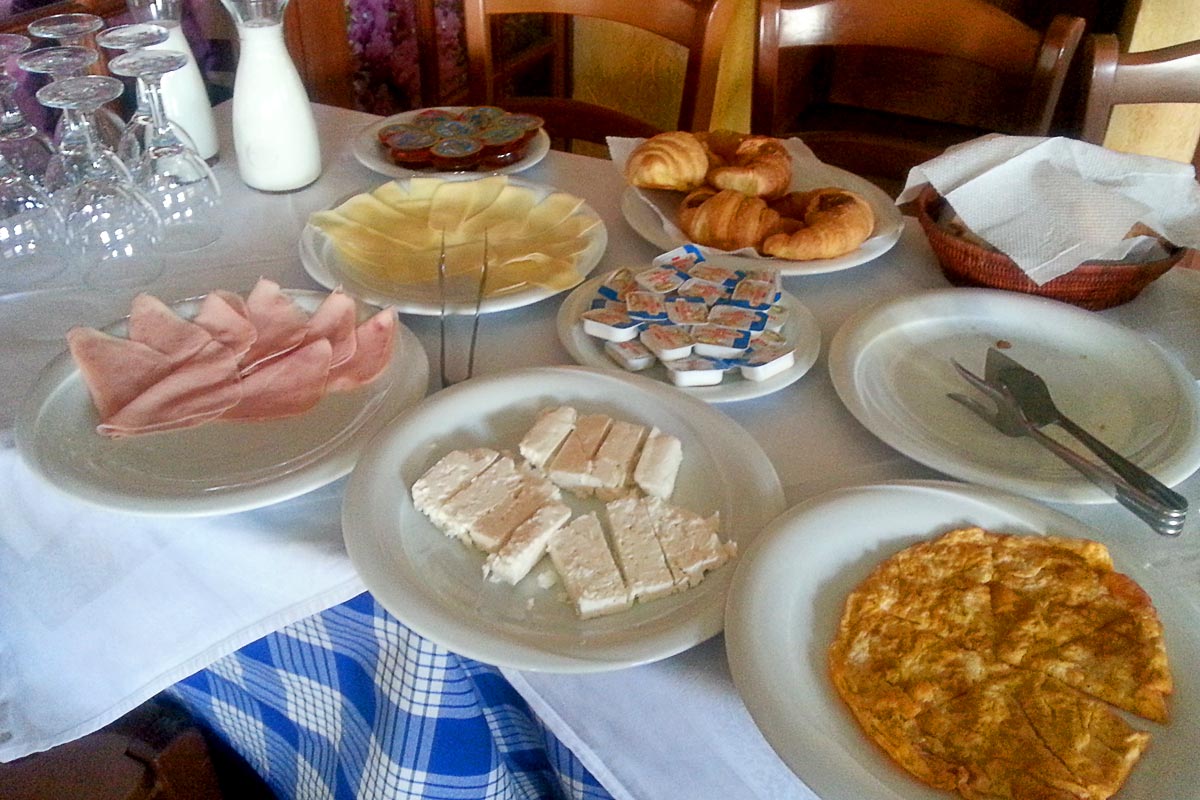
- Breakfast buffets – If your accommodation offers a breakfast buffet it can be a fantastic way to fill up on a variety of tasty food. Breakfast buffets for travelers in Albania usually include bread, cheese, lunch meats, yogurt, coffee, eggs, and juice. If you have trouble with high morning BGs, be careful about these buffets. But they are a good way to fill up and save money by eating a light lunch. Test out your insulin doses and adjust; by the end of your Albania trip you’ll be pretty good at it.
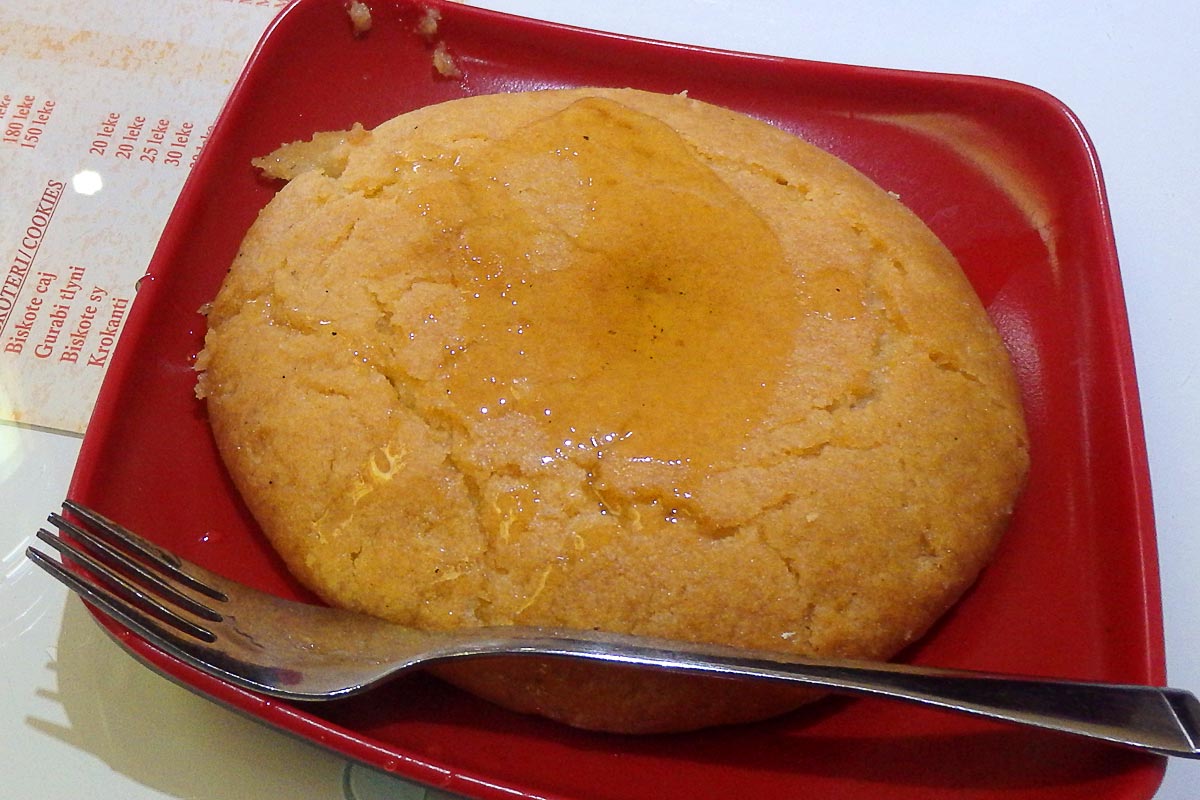
Cookie soaked in honey at an Albanian café – enough Humalog can handle even this.
- Cafés – Modern-looking coffee shops are around in Albania, especially in the capital Tirana. You can find the usual array of sandwiches, pitas, dougnuts, and cakes here. Note that while these can be a good snack or lunch, they are often pretty high in spiky carbs but will probably not have published nutrition info available. If you’re walking a lot then factor that in, but either was try to figure out what you need, inject and eat, and check soon afterwards.
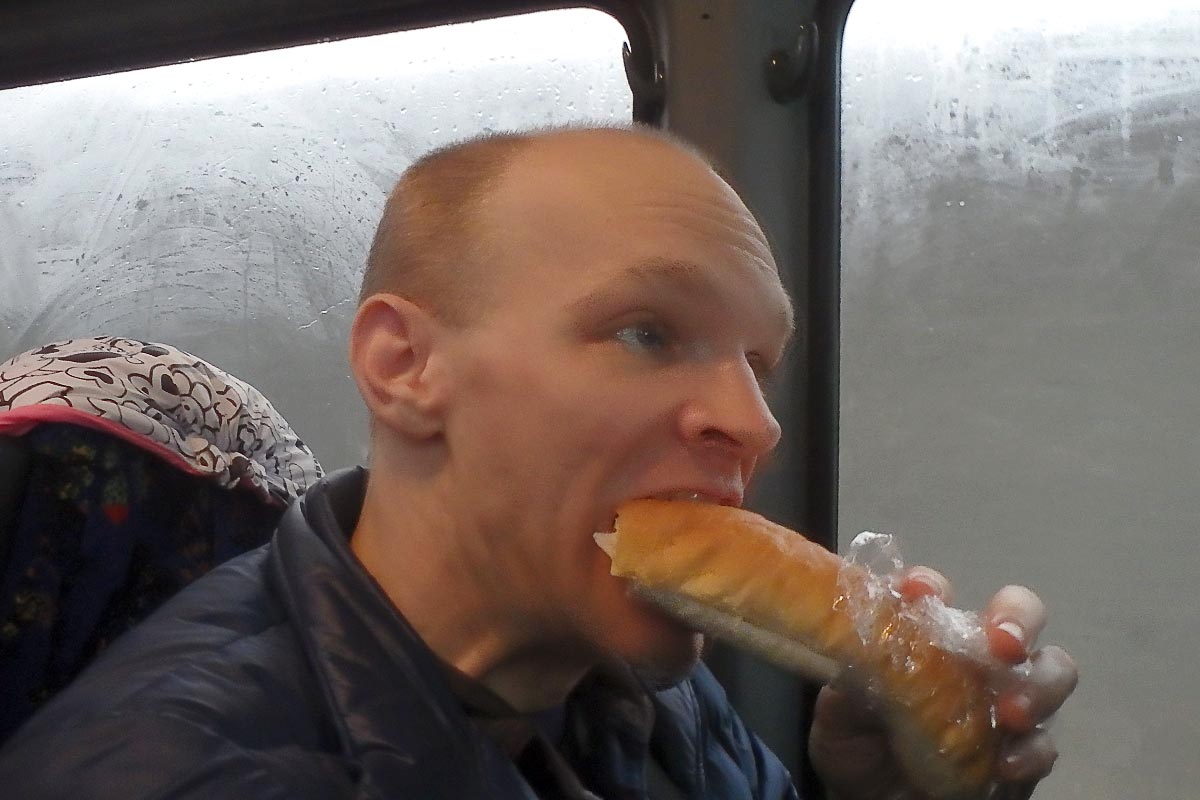
- Bus food – Sandwiches and chips and yogurt, or whatever you can find from a small grocery store or kiosk for a bus trip. Bus travel in Albania relies on an often-unofficial network of private companies, and the minivans that are common won’t have any services on board. Buy what you need before the trip (be sure to allow time for it). Carbohydrate information may be on the packages of the things you buy, but on some things it may not. Make your best guess with your insulin dose in these cases, remembering that the lack of exercise on a hours-long bus ride can make blood sugar higher. Always check afterwards and see how you’re doing.
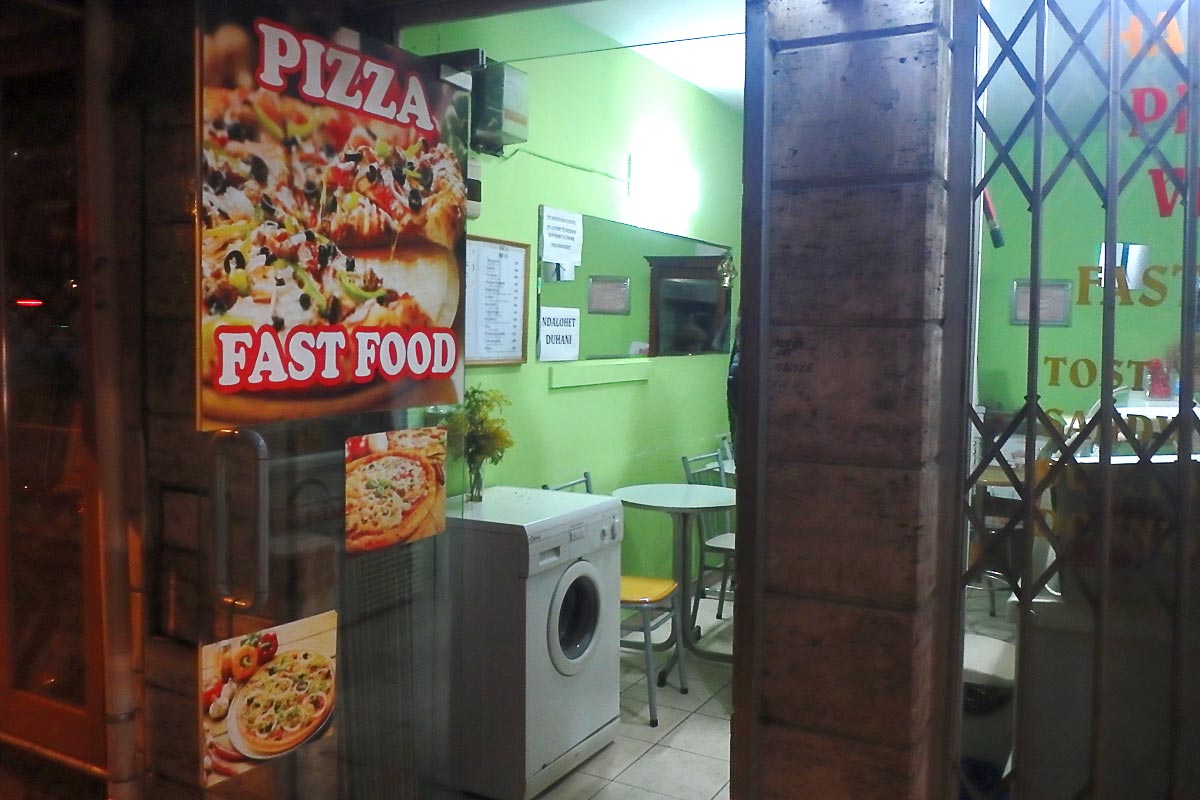
Pizza place with its own laundry machine in Albania.
- Pizza and fast food – As everywhere, pizza (spelled “pica” but pronounced the same) is an easy fallback for dinner after a long day in Albania. The carb content of pizza can be fairly high, so add up the slices you want and take your insulin. Any alcohol may complicate it. Check afterwards and adjust for next time. You may decide to experiment with splitting up your pizza insulin into two injections, before and during/after the meal. Note that pizza can hang around and make you high overnight.
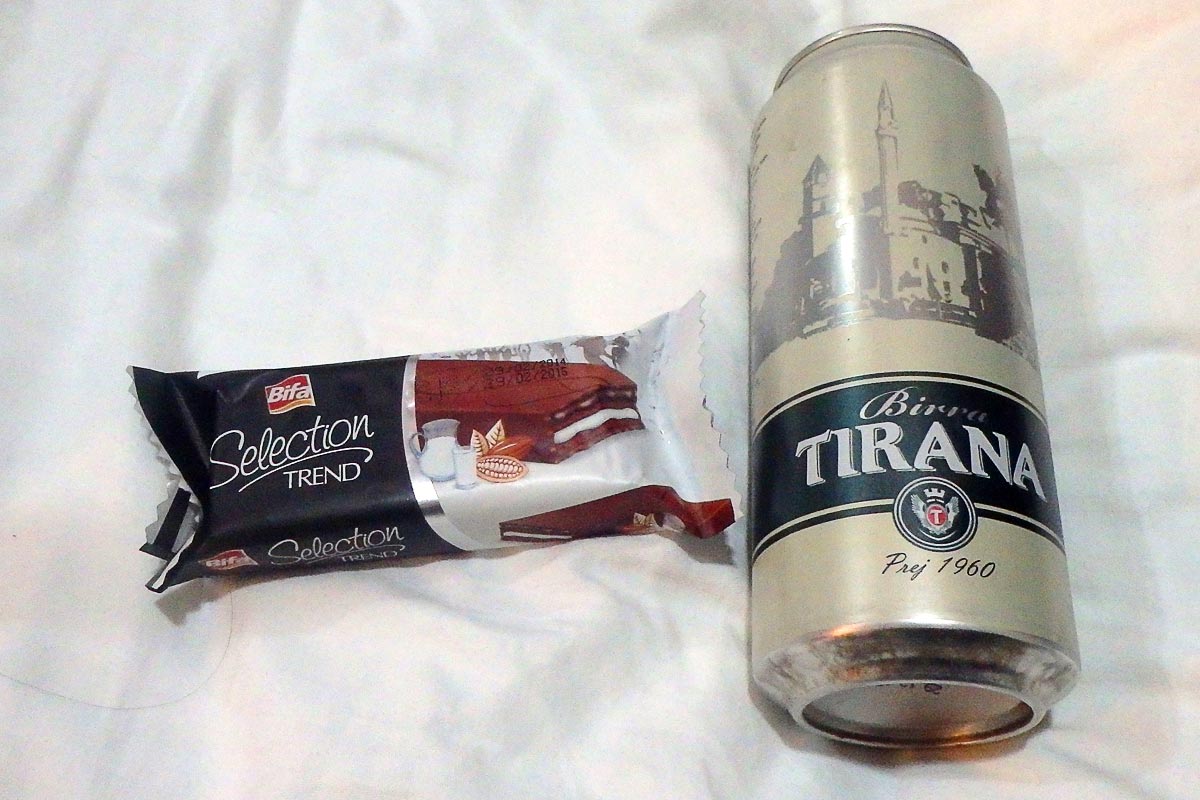
Low blood sugar snack – and a beer, just for fun.
- Low blood sugar snacks – Bottles of juice, chocolate bars, and packaged cookies and cakes are pretty easy to find. Grocery stores and small hole-in-the-wall shops selling basic drinks and foods are frequent in Albania. Choose what works best for you and always buy more when you can – you may take a tour or be on a bus where you can’t buy anything. Don’t get caught without it.
Transportation and Albania with diabetes
You’ll find yourself on highway buses or minibuses, or maybe even in a long-distance taxi, while moving around Albania. There will almost certainly be no snack or drink services on board. You should bring whatever you think you’ll need with you, and don’t count on stopping somewhere.
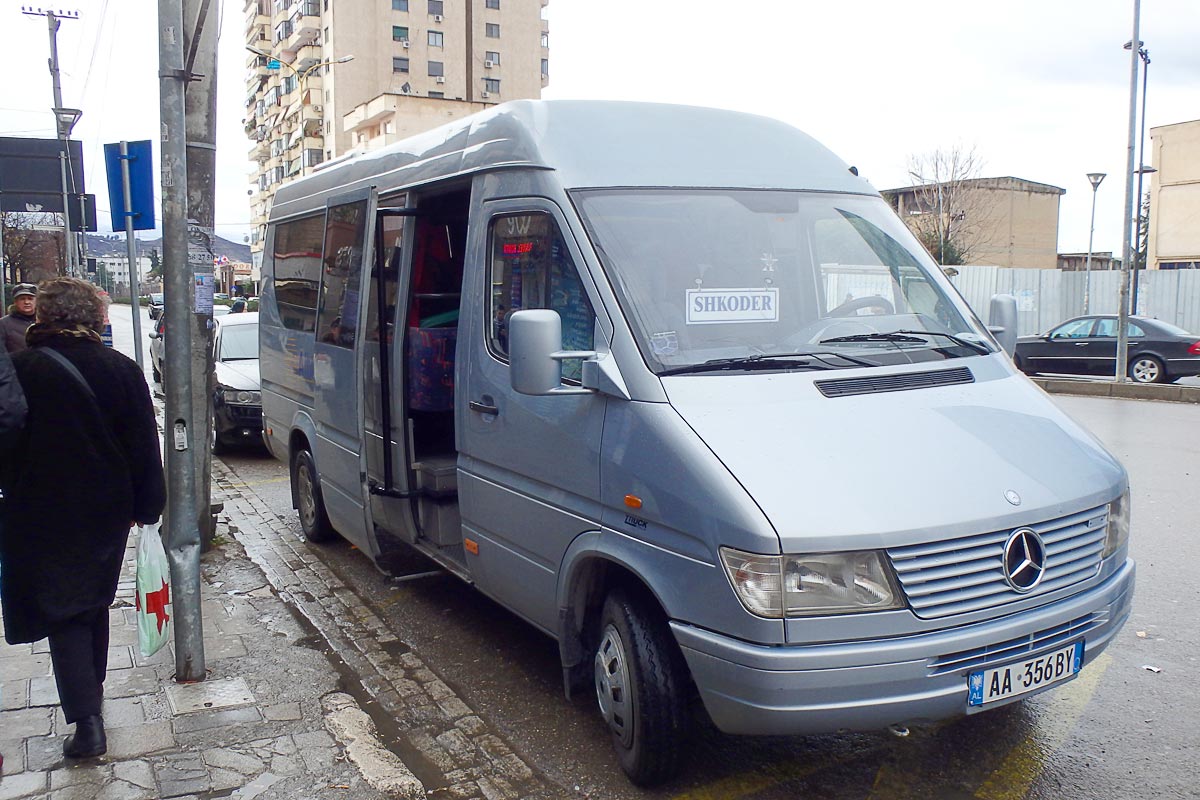
Of course, buses do stop at places where there is a shop, but it can be hard to know when this will happen. Always try to buy something before a long trip – lunch or dinner, of course, but definitely low blood sugar snacks.
Taking insulin in public in Albania
If your insulin delivery system allows for it – i.e., if you use pens or even syringes and inject in an accessible spot on your body – you can probably shoot up at your restaurant table or in your bus seat. If it’s hard to do so discreetly, I’d recommend you go do it in the bathroom of a restaurant, or (on a bus) turn and hide your activities as much as you can. People may not want to see such a thing!
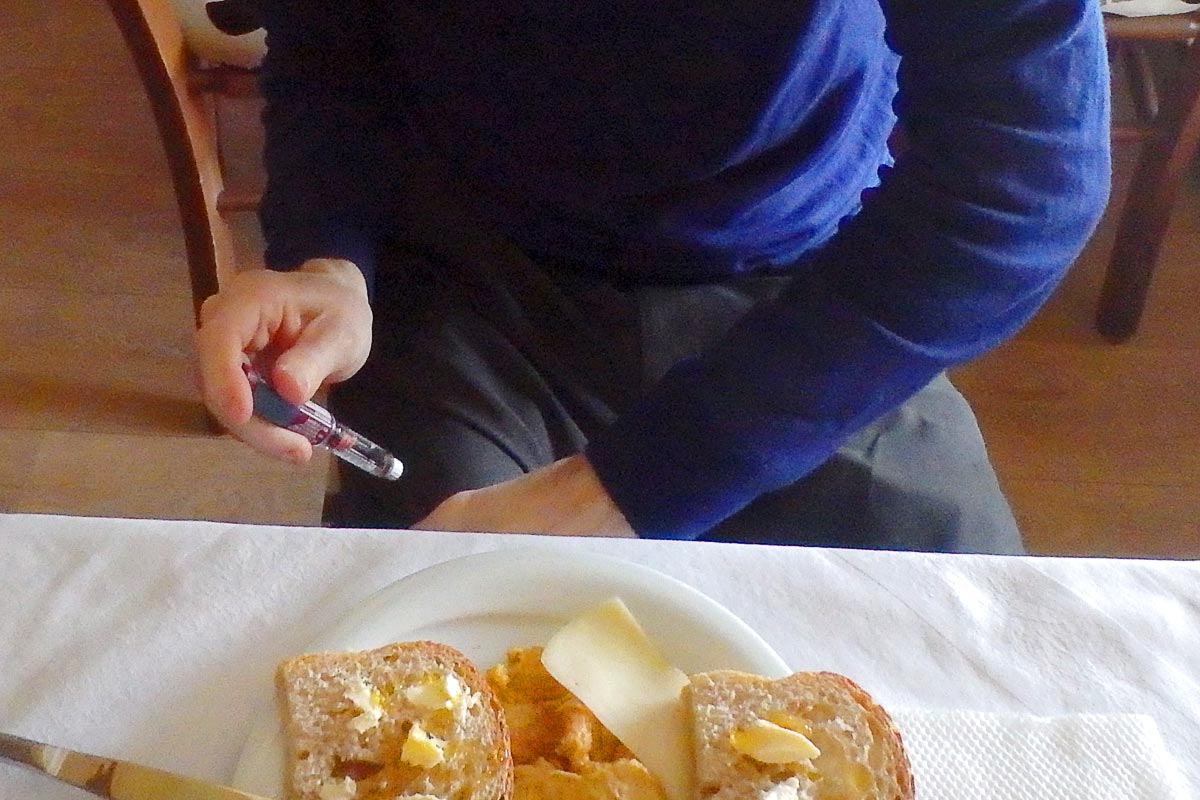
Incidentally, I use pens and my legs, and in Albania I always injected through my travel pants in public. I could do so under the table, or on a bus by contorting a shoulder. You’re not “supposed” to plunge a needle through your clothes but many do – a doctor even once told me there shouldn’t be any problem doing so.
(Read my Full review of Bluff Works travel pants.)
My diabetes experiences in Albania
So what happens when a real diabetic actually goes to Albania? I kept track of my own diabetes when I visited Albania as part of a longer backpacking excursion through Europe. Read my experiences to get a taste of what your own trip to Albania with diabetes may be like. Try to copy what I did right and avoid what I did wrong!
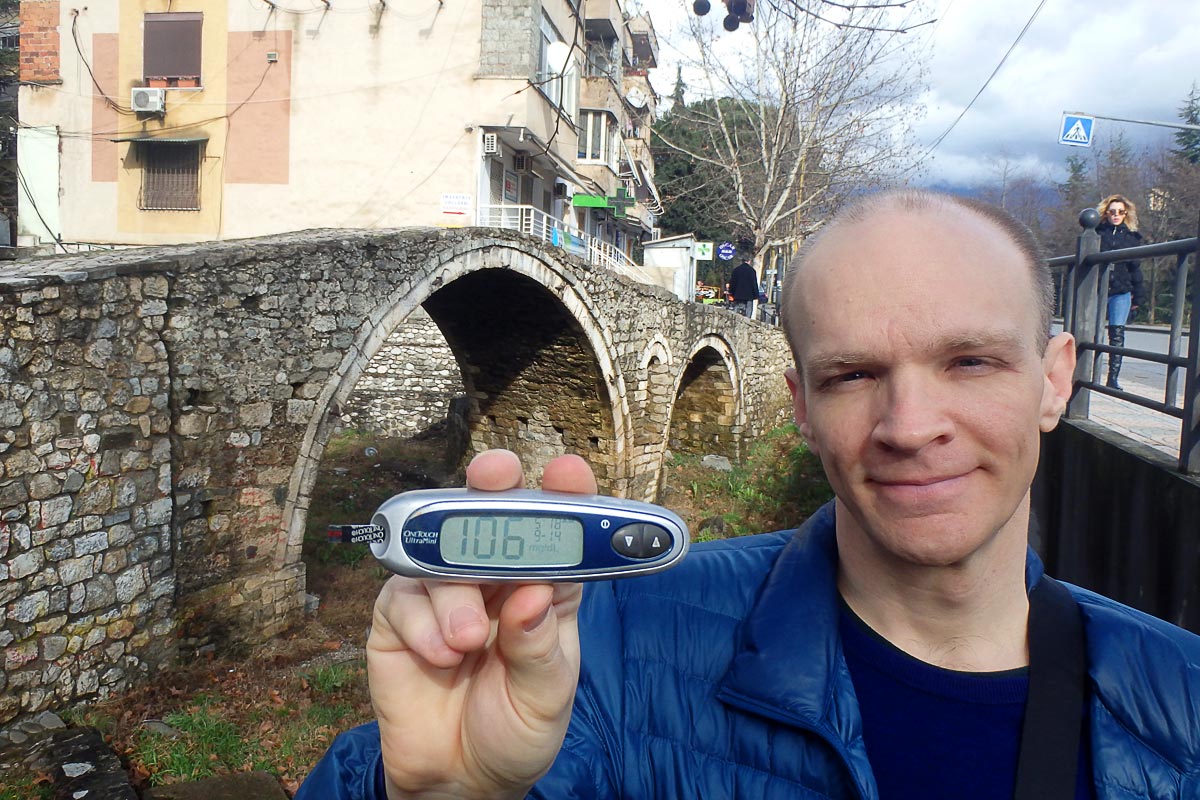
My route in Albania
With my (non-diabetic) travel partner Masayo, I rode in a minibus from Skopje, Macedonia over some lovely but snowy mountains to the capital of Albania, Tirana. After a few days there we found another minibus that took us up to Shkodër, nearer the Adriatic Sea and the border with Montenegro. After a couple of days there, including a bike ride up to the ruins of Rozafa Castle and a surprisingly wide range of foods, we took a bus across the border into Montenegro.
Blood sugar report: Albania
My own experiences with BG in Albania were overall pretty positive: the averages were not perfect, but were a huge improvement over what they had been in, say, Serbia or in Bosnia in preceding weeks. My better readings were a result of my ignoring my unfounded fears of low blood sugars and thus taking sufficient insulin, particularly for dinners.
The data:
- Total number of BG checks: 21
- Average BG: 165
- Lowest BG: 54
- Highest BG: 288
- Average morning BGs (~12:00): 168
- Average afternoon BGs (12:00~6:00): 161
- Average evening BGs (6:00~): 168
That highest reading – 288 – is pretty high, but to have zero readings over 300 represents an achievement for the diabetic traveler, especially when such ultra-high levels were too frequent in recent weeks.
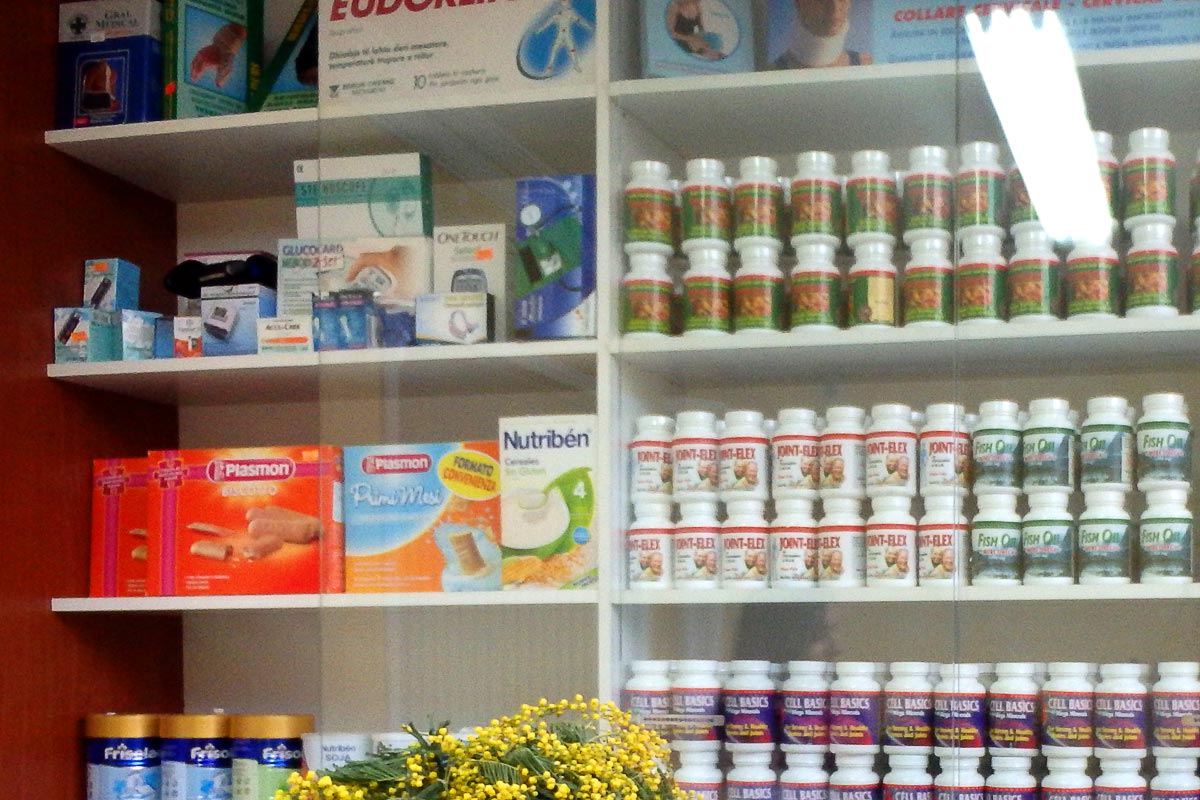
Blood sugar stuff (upper left) in an Albanian pharmacy.
This proves that even if you have bad BGs for an extended period – and “nothing seems to work” – if you keep trying all the time, don’t get too discouraged, and always try to learn what’s happening inside your bloodstream, you will eventually prevail. Like a puppy struggling up a step, as long as you get a hold with one toe you can build on that mini-breakthrough and haul yourself up to success!
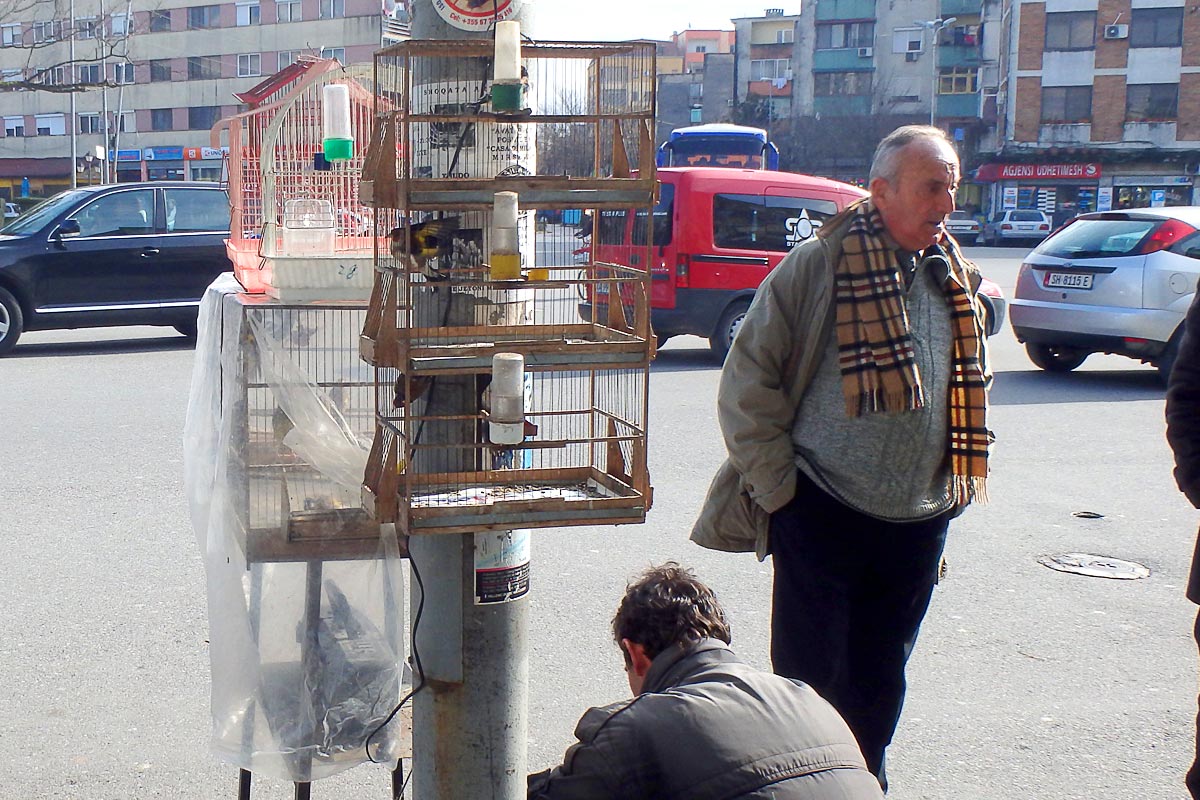
Going to Albania?
If you’re planning (or thinking about planning) a trip to Albania, with diabetes or without, let me know if you have any questions or comments. If you’ve been to Albania I’d love to hear about your own experiences.
Remember to avoid being scared of traveling with diabetes – if you prepare a little and have the right attitude, there isn’t anything you can’t do. Really.
You can go anywhere with diabetes!
Read more about my travels in Albania
Come along on the adventure! Follow detailed travelogues about the wondrous sights, fascinating people, and varied diabetes experiences I encountered as a traveling T1D in Albania:
Day 107: A Wild Bus Into Unknown Eastern Albania
Day 108: Tirana, Albania Is A Weird Patchwork Capital City
Day 109: Communist Amputees And Other Oddities In Albania's Capital Tirana
Day 110: Non-official Minibus Through Albania To Shkodër
Day 111: Obscure Little Rozafa Castle In Shkodër, Albania
Day 112: Fun Bus Ride On Small Roads To Ulcinj, Montenegro
Thanks for reading. Suggested:
- Share:
- Read next: Tips for traveling to Montenegro with diabetes
- News: Newsletter (posted for free on Patreon every week)
- Support: Patreon (watch extended, ad-free videos and get other perks)

Support independent travel content
You can support my work via Patreon. Get early links to new videos, shout-outs in my videos, and other perks for as little as $1/month.
Your support helps me make more videos and bring you travels from interesting and lesser-known places. Join us! See details, perks, and support tiers at patreon.com/t1dwanderer. Thanks!

I’m considering doing some extended work in Albania and have a family member with T1Ds. Came across your blog and just wanted to tell you I think it’s great. We’ll written, very informative and I LOVE the name!
Thank you.
Thanks Laura! Nice to hear. Enjoy Albania, it’s a unique place 🙂
My biggest concern is the use of needles. It’s always a concern of mine when we travel. I worry that people around us -and the authorities – will misunderstand what his needles and syringes are for. Have you run into this problem and what do you suggest we do if we run into this?
Laura,
I’ve had authorities be suspicious of needles once or twice (like in Vietnam) but as soon as I was able to communicate the word “diabetes” they were all smiles and waved me through. Not to say there could be problems but they get used to people traveling with weirdo medical equipment. I recommend staying upbeat and patient.
Jeremy
I have been looking on the internet for how to buy insulin in Albania should you lose your supplies, should your insulin lose potency due to heat, etc. Information on how to obtain new insulin in an emergency is missing from your blog. Which is the first thing I would look at in a Travel blog with Type 1. Bolusing for food…. well, most Type 1s know how to do it. If they can find the carb count. Information on if you can buy insulin over the counter without a prescription, the cost, and what types of insulin are readily available is the first thing a traveling Type 1 looks for. Missing from your blog. I would imagine you could go to the ER of the nearest available hospital but more information would be helpful. And since it is the most important information it should be mentioned early on in the post. P.S. I can find nothing on insulin and Albnia on Youtube or google. Which I find incredible.
Hi Julia,
I know it has been a few years since you asked about getting insulin in Albania, but I am replying to assist others with the same question.
I have checked with multiple parameters, you can buy insulin directly from the pharmacy without a prescription. However, not all types of insulin are available:
-insulin aspart (novolog) is readily available;
-humulin NPH I have been unable to find.
Happy Trails, Toby